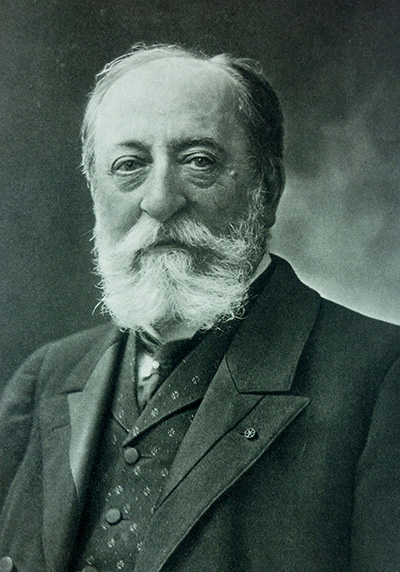Camille Saint-Saëns

- Born: October 9, 1835, Paris
- Died: December 16, 1921, Algiers
Danse macabre
- Composed: 1874
- Premiere: January 24, 1875
- Instrumentation: 2 flutes, piccolo, 2 oboes, 2 clarinets, 2 bassoons, 4 horns, 2 trumpets, 3 trombones, tuba, timpani, bass drum, chimes, crash cymbals, suspended cymbals, triangle, xylophone, harp, strings
- CSO notable performances: First Performance: December 1906, Frank Van der Stucken conducting (an all-Saint-Saëns concert for which Saint-Saëns was present). Most Recent Performance: (CSO) November 1949, Thor Johnson conducting; (Pops) October 2018, Damon Gupton conducting. Recording: Chiller (1989, Telarc label), Erich Kunzel conducting the Cincinnati Pops.
- Duration: approx. 7 minutes

Death is “something that proverbially comes to us all, death is universal and yet universally strange, an object of fascination and of fear…ancient cultures freely personified death…[and] created allegorical figures, like the Grim Reaper…. Death unites us all across the ages,” writes Michael Kerrigan in the introduction to his 2017 book, The History of Death. The living’s fascination with the concept, and the equalizing power of death, certainly extend beyond written history, but the Danse macabre (“Dance of Death”) as an allegorical concept in the arts (drama, music and visual arts) in Western European culture begins to appear during the Middle Ages. The Black Death and the Hundred Years’ war resulted in a cultural obsession with death and the visual depiction of the dead leading all living, regardless of status (king, queen, pope, shopkeeper, musician, etc.), to their graves.
The “Dance of Death” concept waned in popularity during the Renaissance, but found a resurgence in 19th-century French Romantic literature, especially the work of the symbolist poets. The inspiration for Saint-Saëns’ Danse macabre is found in the poetry of one such symbolist poet, Henri Cazalis (1840–1909).
Cazalis had a penchant for dark topics, especially death, including his “Égalité, fraternité…” (“Equality, fraternity”), which tells the story of Death playing his violin as skeletons dance on their graves. In 1872, Saint-Saëns wrote an art song version of the poem.
In 1874, Saint-Saëns reworked the art song into a tone poem, with most of the vocal part covered by the solo violin. Saint-Saëns made good use of the many sounds available in an orchestra to illustrate Cazalis’ text. The xylophone depicts the rattling bones of a skeleton. The scordatura (or “out of tune”) violin provides the sinister tune for the skeletons to dance to and employs the tritone interval, which, in the Renaissance, was named “the devil in music” (diabolus in musica) due to its dissonant and unstable sound.
Saint-Saëns also uses the Dies irae, a Gregorian chant from the Requiem Mass (or Mass for the Dead), an oft-quoted chant that represents death or the Last Judgement.
Listen as the harp strikes midnight on Halloween and Death tunes his violin to awaken the dead to dance upon their graves until the cock’s crow at dawn (represented by the oboe), and Death plays a final consoling tune for the dead to return to their graves.
Saint-Saëns included the following fragment from Cazalis’ poem on the front of his manuscript score, which has been translated (anonymously) in English scores as:
Zig, zig, zig, Death in a cadence
Striking with his heel a tomb,
Death at midnight plays a dance-tune,
Zig, zig, zag, on his violin.
The winter wind blows, and the night is dark;
Moans are heard in the linden-trees.
Through the gloom white skeletons pass,
Running and leaping in their shrouds.
Zig, zig, zig, each one is frisking;
The bones of the dancers are heard to clatter—
But Sst! of a sudden they quit the round,
They push forward, they fly; the cock has crowed!
—Tyler M. Secor